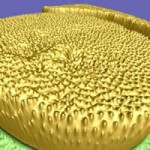I’m always happy to see innovations with glass and mirrors (I hate window cleaning as I always leave streaks no matter how hard I try). So this news warmed my heart: an Alberta-based (Canada) company, House of Mirrors and Glass, has signed a licensing agreement with Diamon-Fusion International [DFI Nanotechnology] for a coating. From the news item on Nanowerk,
The agreement provides distribution of DFI’s NanoPax™ product throughout the Province of Alberta and further expands DFI’s applications into a diverse niche of architectural markets province-wide.
…
“We are very pleased to be a Licensed Distributor of the Diamon-Fusion® patented nanotechnology. Their water and oil repelling qualities have proven to be an important addition to all of our glass products. Diamon-Fusion® improves and protects the treated surfaces, which is so important here in Calgary (Alberta, Canada) due to the presence of hard water mineral deposits. Diamon-Fusion [NanoPax?] is a truly amazing product and should be applied to all glass showers and mirrors” stated Francois Messier, Vice-President of House of Mirrors and Glass.
You may have noticed the confusion in the name for the product vs. the name for the company. I think the product is NanoPax, the company is Diamon-Fusion, and that they sometimes refer to their technology as Diamon-Fusion technology. I have worked in enough high tech companies to know that people confuse the technology as coined by the company because they used their own name (in this case Diamon-Fusion technology) with a product name.
Back on my public engagement soapbox: I was intrigued to see an announcement that a company, JPK Instruments, donated an atomic force microscope (AFM) to the German Museum of Masterpieces of Science and Technology for a display where the public can visit and observe nano research in action. Here’s the company CEO explaining why they made the donation (from the news item on Nanowerk),
Frank Pelzer, CEO of JPK: Back in the fifties, mankind took on big challenges such as space exploration and the moon landing. Without the achievements of those bold pioneers we would today have to do without satellites and numerous other revolutionary applications such as mobile phones, GPS services and satnav systems. Today we are challenged not to look towards the far horizons but, on the contrary, to explore the smallest and most minute details of matter. As we go down to the nano, atomic and molecular levels, we work towards the revolutions of the future – primarily in the medical and life sciences areas. The state of the art in nano research is showcased in the Glass Laboratory at the Museum. Says Frank Pelzer: “We believe that it is very important to give the interested public an opportunity to see nano research in action. This is why we have taken the opportunity of our 10th company anniversary to support the Glass Laboratory through the donation of one of our NanoWizard® series atomic force microscopes.”
Obviously, Pelzer sees public engagement/awareness as important. Btw, that AFM is worth 150,000 Euros ($238,920 CAD).
On an entirely different note, I do find the Japanese approach to robots to be very different from most of what I’m exposed to. From the news item on physorg.com,
In a nation that takes its humanoids seriously, the International Robot Exhibition kicked off this week, showing off the latest whirring and buzzing inventions from 192 companies and 64 organisations from at home and abroad.
Many of the cutting-edge machines on show are eye-popping, but industrial robot “Motoman” also put on a mouth-watering performance, deftly flipping a Japanese savoury pancake called okonomiyaki on a sizzling hotplate.
“It is delicious. Please enjoy,” said the human-size creation of Yaskawa Electric Corp. in a robotic voice.
I was a little more interested in the cardboard robot which will be able to model clothes.

Eager Co.'s cardboard robots at the 2009 International Robot Exhibition in Japan
You can find an enlarged version of this image by using the link I’ve previously provided for the news item.
Yesterday (November 25, 2009), I mentioned that China and the US are both anxious about their innovation and science and technology capabilities and here’s another item which highlights these concerns from a more global perspective while retaining a focus on the US and China, (from the news item on physorg.com),
“Others are catching up fast,” said Marty Hauser, vice president for Washington operations at the Space Foundation, an advocacy organization headquarters in Colorado Springs. “Of particular note over the past decade is the emergence of China’s human spaceflight capabilities.”
Russia now leads the world in space launches. China recently became the third nation, after the United States and Russia, to send its own astronauts out for a spacewalk.
“China is laying the groundwork for a long-term space program with or without us,” said Scott Pace, director of the Space Policy Institute at George Washington University in Washington. “We should worry if we’re not out there with them.”
China’s rocket launch facilities are “state of the art,” Hauser said.
In a competition once limited to the U.S. and the Soviet Union, 60 nations now have their own space agencies, panelists said. Thirteen nations have active space programs, and eight are capable of launching their own satellites into orbit.
I am again reminded that while the Canadian situation seems grave to me; we’re not alone with our worries.
